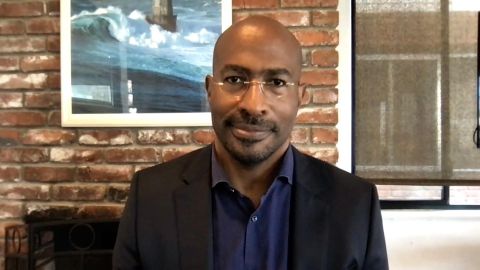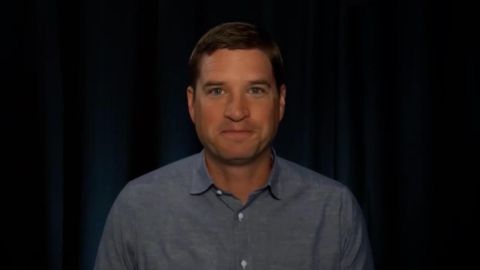Read Transcript EXPAND
CHRISTIANE AMANPOUR: Now, how many e-mails have you received today? And are you on multiple WhatsApp groups? Do you feel sometimes like your brain is in meltdown, trying to cope with it all? Our next guest wants us to radically change the way we communicate in the workplace. Author Cal Newport takes Hari Sreenivasan on a journey now through a world without e-mail.
HARI SREENIVASAN, PBS JOURNALIST: Christiane, thanks. Cal Newport, thank you for joining us.
NEWPORT: My pleasure.
SREENIVASAN: Let’s start with the big basic question. A world without e- mail. Why?
NEWPORT: Well, I’m using a shorthand when I say a world without e-mail, what I really mean is a world without the style of collaboration that email made possible, which I call the hyperactive hive mind. And it’s an approach to work in which we figure most things out on the fly with back and forth ad hoc messaging. My argument is that this approach to collaboration has been both a productivity disaster, but also a psychological disaster for knowledge workers.
SREENIVASAN: OK, let’s break that down a little bit, the productivity disaster part why?
NEWPORT: So if we’re working most things out ad hoc, on the fly with messaging, what happens is we end up with many different asynchronous back and forth conversations happening at the same time, we cannot let them linger too much. If we delay too long answering one of these conversations, things get slowed down. So we have to check inboxes or slack or teams or whatever tool we’re using to communicate, we have to check it all the time. That’s a disaster because our brains can’t context switch that much. If we end up having to check an inbox or chat once every six minutes, which is actually just about average right now. Our brains basically melt down, it takes us 10 or 15 minutes in reality to completely change our focus from one thing to another. So it puts us in this persistent state of self- imposed reduced cognitive capacity were quite literally making ourselves dumber accidentally by working this way.
SREENIVASAN: What is good and what is bad about sort of collaborative problem solving? And why is it twisted in this way, where what is negative about the hyperactive hive mind?
NEWPORT: If the unscheduled nature of the communication, so let’s say for example, which is typical, I have something like two dozen different back and forth asynchronous interactions happening via e-mail over here, we’re trying to schedule a meeting for our client over here, we’re trying to edit a deck over here, we’re trying to figure out a new strategy theme or something like this. Each one of these has messages coming back and forth on schedule. I sent a message at some point someone will respond to it. I can’t really ignore these messages, right, because we have to figure out the client meeting date by the end of the day because he’s coming tomorrow, right?
SREENIVASAN: Yes.
NEWPORT: So I have to keep checking these inboxes to wait for the next message to come in so I can send it back. Now if we scale these over two dozen different conversations, now I constantly have to scale it. If you want to do let’s say collaboration with a group on something, put aside time, get the people together and do group collaboration. That’s fantastic you’ll get you’ll get a lot done, but it’s scheduled, right? You know when that work is happening and you’re giving it your full attention when you can. The thing we have to avoid is the need to always be checking because we never know when that next message is going come. But when it does, we have to answer it right away.
SREENIVASAN: Is some of this action and reaction that we take in the workplace reply, reply all performative? I mean, are we doing this because we think it’s sort of like the equivalent of making sure the boss sees that I’m working?
NEWPORT: There is a performative aspect of the hyperactive hive mind. If this is the main way work happens, it opens the door to the sort of performative signaling of activity, which comes with, I think, lots of issues. But one thing I like to emphasize is that it is not entirely performative because sometimes I’ll get the reaction to this that says, no, no, if we could just change the norms or we could get people to have better expectations or we could get people to send smarter e-mails we’d be fine. My argument is we cannot solve the problem by repairing our relationship through our inboxes. We actually have to stop those inboxes from getting so full in the first place, and that means changing underapplying processes. We don’t just send e-mails to schedule client meetings. We use this system. We don’t just rock and roll on slack when trying to come up with a new theme for our marketing campaign. It is Monday mornings, from 9:00 to 9:30 and we do it in whatever this conference room and it is highly structured and you have to write the memo the weekend before so we can all read it. We have to actually replace the hive mind with a specific alternative.
SREENIVASAN: This is a multibillion-dollar industry, trying to figure how to get offices to communicate efficiently. You have got so many different players in it, right? You have got Microsoft, the people who made e-mail ubiquitous through their office application. You’ve got Slack, which is kind of an instant messaging. Microsoft has Teams. You know, there are so many different ways to do it. What are they getting wrong? What are they missing? Because they seem to be going after e-mail saying, well, e-mail wasn’t so efficient but chatting almost like texting back and forth is. Does that solve anything?
NEWPORT: Well, here is what happens. So, we fell into this hyperactive hive mind workflow basically by default. Once we started working this way, we realized there are shortcomings with e-mail as a tool if the way we’re going to collaborate is back and forth ad hoc messages. So, we invented new tools like Slack, like Teams that basically implemented the hyperactive hive mind better. I think that’s why people have a love/hate relationships with these tools. On the one hand, this is the way you are going collaborate. It is a smoother tool for doing so, on the other hand, we keep this way of collaborating. So, I think, a lot of people right now has been, OK, I guess we’ll just stipulate that this constant back and forth ad hoc messaging is how we’re going work, and once we do that we can say, what’s the best tool, and sure, Slack is probably better than an old e-mail client, then that’s what you’re going to do. But my argument is that that way of collaboration itself is causing a lot of trouble. We need to think much bigger. Not how do we do this faster but how do we replace this whole way of collaborating altogether.
SREENIVASAN: You know, this conversation is more around today because we are facing the potential of a remote working environment being extended out into longer futures. Depending on the industry, depending on what city you work in, depending on what kind of company you work in, people are rethinking, well, what is the best way for an employee to work? And then, what are the tools that can make that happen? Well, ultimately, there have been many people who have researched what the mix should be. What did you find when you were writing this book?
NEWPORT: Well, some of it became clear is that the hyperactive hive mind is not very compatible with fully remote work. That if you look at knowledge sector companies that are relatively successful with remote work, what you tend to find, the unifying factor is they have much more structured approaches how they collaborate, how they keep track of who is working on what, how they communicate about the work, how much work do you think anyone should have on their plate at the same time. In the absence of that structure when everyone is remote and everything is abstractions, you’re just a slack handle or e-mail address and communication is just flying back and forth and Zoom invites are just flying back and forth, things spiral out of control. And I think a lot of people experience that over the last year and a half, a lot of knowledge workers found themselves in back-to-back-to-back-to-back Zoom trying to do e-mail and Teams chats simultaneously and getting basically no actual work done. Remote work requires structure. I think there is no way around that.
SREENIVASAN: So, give me an example of some good behaviors and good structures and infrastructures that companies have put into place. What should we be doing to try to not just maximize productivity but, you know, just be sane and humane with each other?
NEWPORT: Well, one example of a sector within knowledge work that has traditionally had lot of success with remote work, for example, is software development. And why is this? Because they have already put in place usually pretty structured modes of collaboration. Most of these shops, they’re using what are known as Agile Project Management Methodologies. They have a shared board where every task is listed, you know who is working on what. They have a highly structured morning meeting where all of the communication about the work happens. They actually care about how much stuff is on your plate at the same time. This is an example of a type of work in which they can go remote or not remote without much issues. Another example I found in my research are these so-called ROWE companies, R-O-W-E which stands for Results Only Work Environment. And these are companies that have really changed their cultures so that it’s results oriented, when you work, where you work, how you work is made less important, you just clearly identify, here’s what I’m working on, here is when I’m going the get it done, here’s when we need to communicate to get that done. These high structured environments also don’t have the same issues of constant e-mail overflow. And during the pandemic, they went remote and back and remote with basically no issued at all.
SREENIVASAN: You talk a little bit in the book and other place about deep work. What does deep work mean and what do we need to do to create an environment for ourselves where we can execute that way?
NEWPORT: The deep work is where you are able to focus on something that is cognitively demanding without context shifting. So, you can give it your full attention without having to check an inbox every five minutes, without having to look at Slack, without having to glance at your phone. When you are in a state of deep work, where you’re actually giving something your full unbroken concentration, you get a lot more out of your brain than when you are not, when you’re half attention, when you’re half context shifting. And one of the arguments I made in the book I wrote about deep work, it was eponymously called “Deep Work,” is that this is an incredibly valuable activity especially in the knowledge economy. We should be prioritizing and supporting it but we don’t and it is almost impossible. And why is that impossible? Because of the hyperactive hive mind demands that we constantly check all these inboxes.
SREENIVASAN: You know, when you talk about deep work I want to ask if that’s something that is a luxury. You know, I remember reading a long time ago Marc Andreessen said that he would only check e-mail twice a day. I’m like, wow. That must be nice. I mean, you’re are the CEO. You are the boss, at the time, Netscape, right? You can afford do that. But all of your subordinates or people who report to you, they can’t afford do that, or if I’m the end level — lowest level person in an organization, I can’t afford not to be on e-mail because my boss might ask me something, right, or some other colleague might?
NEWPORT: Let’s say you are in an administrative assistant style support role, well, you are not spending four hours at a time working on one thing, your task preventing to be smaller, but we would like to set things up so you could do one thing at a time and not have to be constantly servicing Slack and e-mail and switching your context back and forth. Now, let’s say you were a computer programmer, the one thing you were doing at a time might be writing a tricky algorithm, so to do one thing at a time might mean hours of work in a row before you move on to something else. And so, those durations differ but regardless of the job. But regardless of the job, I think human neuroscience is pretty clear, humans do best when they do one thing at a time.
SREENIVASAN: Is there something changing about how we perceive our relationship to work? I mean, for a lot of people, the pandemic forced them to see the things that they had compromised and sacrificed in order to go to the office. And all of a sudden having, perhaps, this is again white- collar workers who are privileged enough to take this time to do this, they were starting to reflect on why am I doing this? And we have also a kind of generational difference here in how younger people perceive their relationship to work than older people.
NEWPORT: I think there is definitely a disruption occurring, I think definitely the pandemic is pushing it. When you look at sort of knowledge workers, kind of like generically educated knowledge workers, so workers who can do many different types of jobs, not someone who is trained in one very specific skill, we’re seeing a shuffling and downsizing seems to be happening. The shuffling is people changing locations and jobs, maybe even just for novelty or variety. And the downsizing is people actually literally reducing the footprint of paid employment in their life. Maybe if I lived somewhere cheaper, I don’t have to work as hard at any job. I think knowledge work in particular is really susceptible to these types of disruptions because unlike other types of labor it is very ambiguous. You know, we’re in an office and there is a computer and we’re doing e-mail all day and it is actually kind of hard to point at sometimes, I made that or I helped produce this or here’s the locomotive that my team turned off the Baldwin (ph), they simply went. In the absence of that, it’s sort of a weird almost half seem of a lack of a work. You can feel that way sometime. Just a flurry of slack and PowerPoint. And because it is so ambiguous, it is really ripe for disruption when something changes and knocks us out of our cultural conventions about work and we say, well, how much of this do I want to do? How much of my life do I want to spend hitting — you know, entering my Slack chat box? What do I really do for a job? I think a lot of this reflection is happening and I think a lot of this is happening in part because we have not yet done the hard work in knowledge work of actually getting better at defining work, having good metrics, structuring work, making it something more craft oriented, more deep work. We allowed knowledge work to be much more ambiguous and hyperactive and back and forth communication, that’s a type of work that I think is much more prone to huge shifts in our employment.
SREENIVASAN: So, how do we decrease our reliance on technology where we’re spending so much of it, using so much of it to manage relationship virtually instead of just being productive?
NEWPORT: Well, yes. Now, we can talk about the personal aspect of technology and things get a little bit tricker. And I think there’s two elements to this. So, one thing I’ve heard from companies during the remote work aspect of the pandemic are saying, yes, there is this productivity hit from being on Slack or their e-mail all day but as a side effect, we are getting more interaction with each other, should otherwise be isolated and typically, my response is separate the two goals. So, we have the goal of actually how do we collaborate Let’s find the most effective way to collaborate and then we have this other goal, how do we foster connections and relationships while we’re remote? Solve that problem separately and directly. What are we going to do as an organization to keep people feeling connected? Don’t mix those two things together. Don’t say, we’re going to be hardly unproductive so that we can be more connected. I’m sure we can find to way to be more connected and also be productive. And then, of course, we have the technologies in our personal life, social media, Zoom, Face app, WhatsApp and it’s all very important for connecting to people we just have to deploy it carefully. We have to know why we’re deploying it. I wanted to talk to my uncle on a regular basis is a great use of Zoom but I’m going to use Twitter as a way to escape feelings of dread or just to numb myself is a bad use of technology. We have to asking and answering those questions, what am I trying do, how do I use these tools to accomplish it?
SREENIVASAN: Is this going to be a flash in the pan? This idea that we’re going to be able to work remotely? I mean, because you already see certain companies pulling very hard to try and get their employees to all come back to the building.
NEWPORT: So, my prediction is, if your company does not revamp how you actually collaborate, right, we’re going to revamp it so that it is more conducive for remote work, which means getting the way from just this always on back and forth messaging. If you didn’t — don’t do that, almost certainly the friction will build up to the point where within one year everyone will be back in the office. So, I think that is are where the gravitational force is right now. I mean, we’re already seeing this at companies. We’re seeing this, you know, Apple moving back to we need you to be here two days a week or three days week. We cannot change the way work happens just with memos, just with saying here is our new rule. You actually have to change the way work happens just with memos, just with saying, here’s our new rule for how we’re going to work. You actually have to chance the cultural work. So, I don’t know what’s going to happen, because to me it all comes down to how many companies are going to be motivated enough to go through the pain of changing fundamentally how they work to get away from the convenience of the hyperactive hive mind to something more structured and more effective. Those that do that will, I think, sustain large amounts of remote work. And those that don’t, I don’t think can. I just don’t know how many are going through the pain right now. So, it’s going to be very interesting to observe over the next few years.
SREENIVASAN: The book is “A World Without E-mail.” Cal Newport, thanks so much for joining us.
NEWPORT: Thanks for having me.
About This Episode EXPAND
Alok Sharma; Kate Orff; Cal Newport; Van Jones
LEARN MORE



